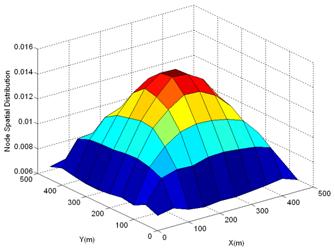|
The Random Waypoint Model was first proposed by Johnson and Maltz. Soon, it became a 'benchmark' mobility model to evaluate the MANET routing protocols, because of its simplicity and wide availability.
The implementation of this mobility model is as follows: as the simulation starts, each mobile node randomly selects one location in the simulation field as the destination. It then travels towards this destination with constant velocity chosen uniformly and randomly from  , where the parameter , where the parameter  is the maximum allowable velocity for every mobile node [2]. The velocity and direction of a node are chosen independently of other nodes. Upon reaching the destination, the node stops for a duration defined by the ‘pause time’ parameter. If is the maximum allowable velocity for every mobile node [2]. The velocity and direction of a node are chosen independently of other nodes. Upon reaching the destination, the node stops for a duration defined by the ‘pause time’ parameter. If , this leads to continuous mobility. After this duration, it again chooses another random destination in the simulation field and moves towards it. The whole process is repeated again and again until the simulation ends. , this leads to continuous mobility. After this duration, it again chooses another random destination in the simulation field and moves towards it. The whole process is repeated again and again until the simulation ends.
There are two implementation of this model in the software: Firstly, Random Waypoint without reflection, which only selects a destination point within the map, so it needs no reflection. This model works with Simple Maps. Secondly, Random Waypoint model, which works with Reflective Maps.

Spatial Node Distribution in Random Waypoint Mobility Model |